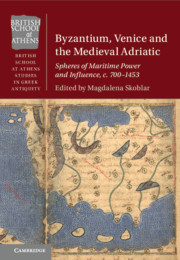Book contents
- Byzantium, Venice and the Medieval Adriatic
- British School at Athens Studies in Greek Antiquity
- Byzantium, Venice and the Medieval Adriatic
- Copyright page
- Contents
- Figures and Maps
- Tables
- Contributors
- Foreword
- Acknowledgements
- Note on Citation, Transliteration, Names, Titles and Dates
- Maps
- Introduction
- 1 The Adriatic Sea 500–1100
- 2 Thinking of Linking
- 3 A Winter Sea?
- 4 The Origins of Venice
- 5 The Northern Adriatic Area between the Eighth and the Ninth Century
- 6 Provincia Iadrensis
- 7 Ravenna and Other Early Rivals of Venice
- 8 Byzantine Apulia
- 9 From One Coast to Another and Beyond
- 10 Icons in the Adriatic before the Sack of Constantinople in 1204
- 11 The Rise of the Adriatic in the Age of the Crusades
- 12 Venice in the Twelfth Century
- 13 Venice, the Ionian Sea and the Southern Adriatic after the Fourth Crusade
- 14 Sea Power and the Evolution of Venetian Crusading
- 15 Reassessing the Venetian Presence in the Late Medieval Eastern Adriatic
- 16 ‘Strangers in the City?’
- Conclusion
- Index
- References
4 - The Origins of Venice
Between Italy, Byzantium and the Adriatic
Published online by Cambridge University Press: 26 March 2021
- Byzantium, Venice and the Medieval Adriatic
- British School at Athens Studies in Greek Antiquity
- Byzantium, Venice and the Medieval Adriatic
- Copyright page
- Contents
- Figures and Maps
- Tables
- Contributors
- Foreword
- Acknowledgements
- Note on Citation, Transliteration, Names, Titles and Dates
- Maps
- Introduction
- 1 The Adriatic Sea 500–1100
- 2 Thinking of Linking
- 3 A Winter Sea?
- 4 The Origins of Venice
- 5 The Northern Adriatic Area between the Eighth and the Ninth Century
- 6 Provincia Iadrensis
- 7 Ravenna and Other Early Rivals of Venice
- 8 Byzantine Apulia
- 9 From One Coast to Another and Beyond
- 10 Icons in the Adriatic before the Sack of Constantinople in 1204
- 11 The Rise of the Adriatic in the Age of the Crusades
- 12 Venice in the Twelfth Century
- 13 Venice, the Ionian Sea and the Southern Adriatic after the Fourth Crusade
- 14 Sea Power and the Evolution of Venetian Crusading
- 15 Reassessing the Venetian Presence in the Late Medieval Eastern Adriatic
- 16 ‘Strangers in the City?’
- Conclusion
- Index
- References
Summary
In recent years research on the early medieval north-eastern Italy has made important advances in the study of archaeological finds from the entire Adriatic area but also in the field of critical analysis of the early Venetian duchy’s relations with the Lombard (and later Italian) kingdom and Byzantine Italy. This study focuses on the second subject, starting from the arrival of the Lombards in 569, which established the conditions for the birth of Venice. From the sixth to the ninth century, Venice was a Byzantine duchy embedded in a dense network of political, social and economic relations which extended across the whole northern Adriatic. The formation of Venetian society and the city itself, its institutions and political identity were profoundly influenced by social and institutional developments on the Italian mainland. Simultaneously Byzantine, Adriatic and Italian in character, Venice developed in delicate equilibrium with all these different social components.
- Type
- Chapter
- Information
- Byzantium, Venice and the Medieval AdriaticSpheres of Maritime Power and Influence, c. 700-1453, pp. 98 - 110Publisher: Cambridge University PressPrint publication year: 2021



